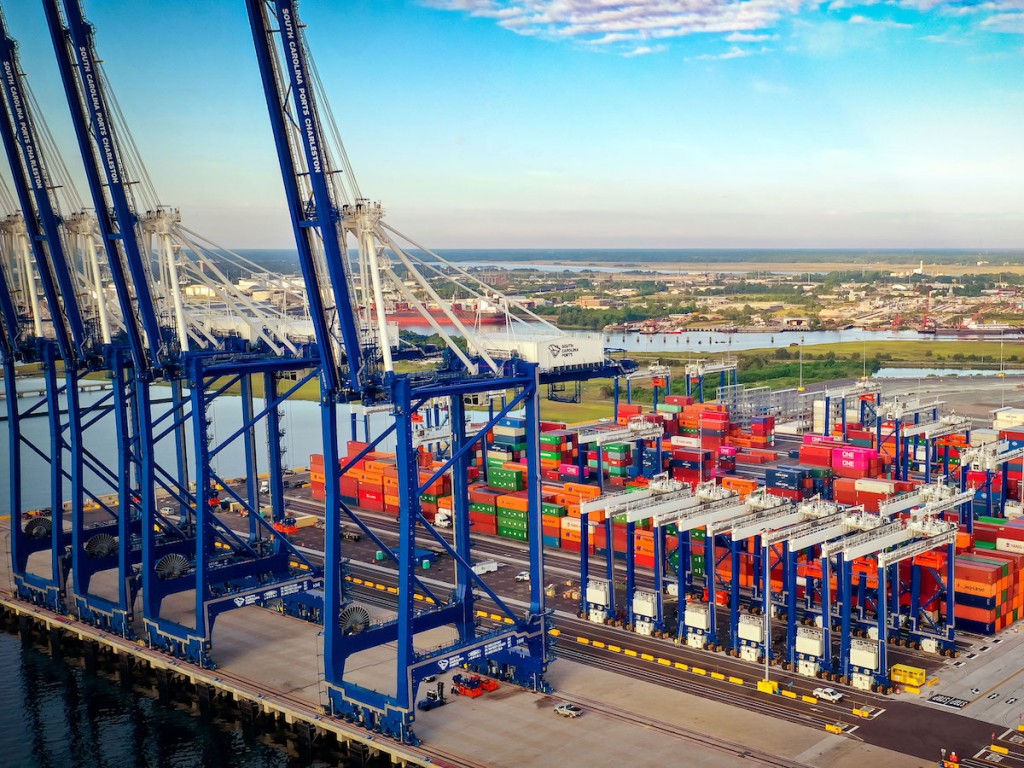
With this year’s opening of the first U.S. greenfield container terminal in more than a decade plus significant modernization of its venerable Wando Welch Terminal, the South Carolina Ports Authority’s Port of Charleston is exceptionally positioned to fluidly move burgeoning volumes on and off megacontainerships.
“As the only port in the country with new terminal capacity, SC Ports has the ability to handle the growing cargo volumes and rising retail imports coming through the Port of Charleston,” James I. “Jim” Newsome III, president and chief executive officer of the South Carolina authority, told AJOT.
The Port of Charleston’s increased big-ship-handling capability is coming at a propitious time, amidst a pandemic-spurred increase in U.S. consumer spending and concomitant import boom and heightened distribution hub capacity demand.
“Amid ongoing supply chain challenges, SC Ports’ capacity, berth availability and efficient operations are more important than ever,” Newsome said.

Operations were launched in March at the first phase of Hugh K. Leatherman Terminal, built on a former U.S. Navy base site in North Charleston, where the port permitting process began back in 2003. The initial Leatherman phase is adding 700,000 TEUs of yearly capacity at the Port of Charleston. At full build-out, a three-berth Leatherman facility is to offer 2.4 million TEUs of annual throughput capability.
A similar 2.4 million TEUs of yearly capacity is to be provided by the modernized Wando Welch Terminal, a four-decades-old facility that, in this latest $500 million renovation, is seeing its contingent of ship-to-shore cranes increase to 15 units with 155 feet of lift height, augmented by 65 rubber-tired gantries and a stronger wharf. The last two of those cranes are slated to be operational by early 2022. The Wando Welch Terminal can simultaneously handle as many as four megacontainerships, each with a capacity of 14,000 or more TEUs.
Furthermore, the nearly $600 million Charleston Harbor Deepening Project, funded by state and federal dollars, is on track to achieve a 52-foot depth in 2022, to give Charleston the deepest harbor on the U.S. East Coast, capable of accommodating the biggest of boxships at any time under any tidal conditions.
“All of this puts us in a very unique situation to be able to grow without congestion,” Newsome said. “We have no congestion right now. The port works very reliably, and we are able to get ships in and out fast.”
SC Ports already has been handling record volumes. In the first eight months of calendar 2021, the Port of Charleston handled 1,814,602 TEUs, putting it on pace to far exceed the 2,309,995 TEUs moved in 2020 and also surpass the calendar-year record 2,436,184 TEUs handled in 2019.
With such a dramatic rise in activity, SC Ports also is enhancing its intermodal capabilities for getting cargo to and from inland destinations.
Supported in part by a $25 million U.S. Department of Transportation grant, expansion is under way at SC Ports’ Inland Port Greer, the first phase of which opened just off Interstate 85 in Upstate South Carolina in 2013, with BMW Manufacturing Co. as its launch customer. The Greer facility extends the Port of Charleston’s reach 212 miles inland via Norfolk Southern rail, with 94 million consumers reachable within a one-day truck trip from the inland terminal.
Meanwhile, SC Ports is developing the Navy Base Intermodal Facility, a cargo yard near Leatherman Terminal that is to be served by both CSX and Norfolk Southern. That facility, targeted for completion within three years, is part of a $500 million-plus project that also encompasses an inner harbor container-on-barge operation for moving boxes between Wando Welch Terminal and Hugh K. Leatherman Terminal.
At the same time, with the continuing boom in retail imports, SC Ports is actively working with retailers to find transload and warehouse capacity to expedite peak-season volumes. SC Ports operates a transload facility at Wando Welch Terminal, handling cargo for e-commerce business of megaretailers.
A 3-million-square-foot Walmart import distribution center is on schedule to open in January on port-owned land in Ridgeville, South Carolina, about 35 miles northwestward up Interstate 26 from the Leatherman terminal.





